<< Previous | Displaying results 2701-2750 of 6769 for "" | Next >>
Ludwig Beck, one time chief of the Army General Staff. After his resignation in 1938, Beck became the center of the military resistance to Hitler. He was executed in 1944 for his role in the July 1944 attempt to kill Hitler. Germany, date uncertain.
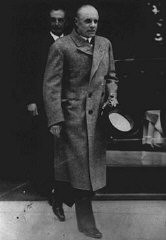
Carl Goerdeler, former mayor of Leipzig and a leader of the July 1944 conspiracy to kill Hitler, stands trial before the People's Court in Berlin. He was condemned and executed at Ploetzensee prison on February 2, 1945. Berlin, Germany, 1944.
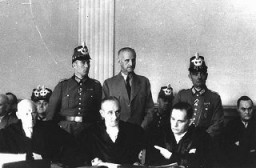
Eugen Bolz, a member of the Catholic opposition to Hitler, during his trial before the People's Court. He was arrested following the attempt to kill Hitler in July 1944 and was executed at Berlin's Ploetzensee prison on January 23, 1945.
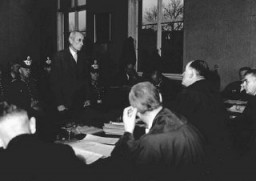
Carl Heinrich Langbehn was an attorney who was slated for a possible cabinet seat had the July 1944 attempt on Hitler's life succeeded. He is pictured here on trial before the People's Court in Berlin. Langbehn was executed in the Ploetzensee prison on October 12, 1944.
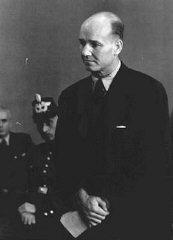
Roland Freisler (center), president of the Volk Court (People's Court), gives the Nazi salute at the trial of conspirators in the July 1944 plot to kill Hitler. Under Freisler's leadership, the court condemned thousands of Germans to death. Berlin, Germany, 1944.
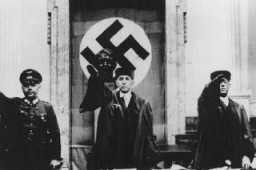
Entrance to the Ploetzensee prison. At Ploetzensee, the Nazis executed hundreds of Germans for opposition to Hitler, including many of the participants in the July 20, 1944, plot to kill Hitler. Berlin, Germany, postwar.
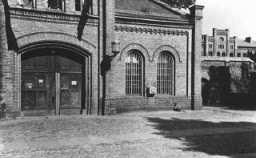
Execution site at the Ploetzensee prison. At Ploetzensee, the Nazis executed hundreds of Germans for opposition to Hitler, including many of the participants in the July 20, 1944, plot to kill Hitler. Berlin, Germany, postwar.
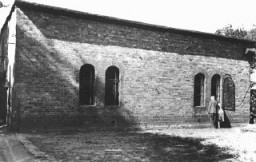
Portrait of a preschool class in Copenhagen. Gus Goldenburger (top row, second from left) was one of the few Jewish students in the class. His family moved to Denmark from Czechoslovakia, fearing the rising tide of Nazism. When the Nazis planned to deport Danish Jewry, the Goldenburgers managed to escape to Sweden, where they remained until the end of the war. After the war, the Goldenburgers returned to Copenhagen. Photograph taken in Copenhagen, Denmark, 1938–1939.
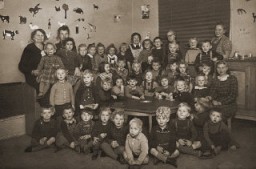
King Christian X. According to popular legend, King Christian X chose to wear a yellow star in support of the Danish Jews during the Nazi occupation of Denmark. In another version, the Danish people decided to wear a yellow star for the same reason. Both of these stories are fictional. However, the legend conveys an important historical truth: both the King and the Danish people stood by their Jewish citizens and were instrumental in saving the overwhelming majority of them from Nazi persecution and death.
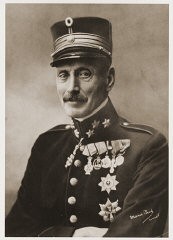
Portrait of Georg Duckwitz, German naval attache in Denmark who leaked the Nazi plan to deport Danish Jews. Place and date uncertain.
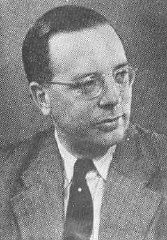
A boat used by Danish fishermen to transport Jews to safety in Sweden during the German occupation. Denmark, date uncertain.
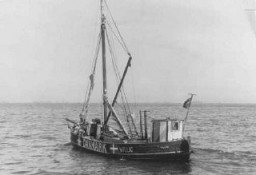
Jewish refugees being rescued aboard a Danish fishing boat bound for Sweden. October 1943.
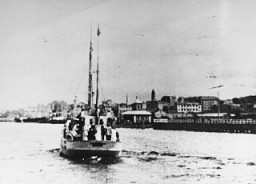
Danish refugees register in Sweden after escaping from Denmark. Sweden, after October 1943.
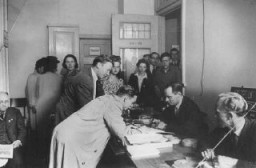
Jewish refugees from Denmark upon arrival in neutral Sweden. 1943.
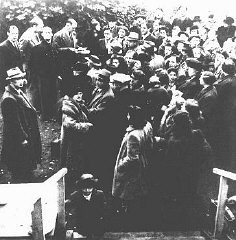
The Danish Freedom Council, Denmark's unofficial government-in-exile from July 1944 to May 1945, was made up of leaders of the four main resistance groups. London, Great Britain, between July 1944 and May 1945.
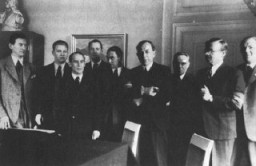
Excerpt from Anne Frank's diary for the date October 10, 1942: "This is a photograph of me as I wish I looked all the time. Then I might still have a chance of getting to Hollywood. But now I am afraid I usually look quite different." Amsterdam, the Netherlands.
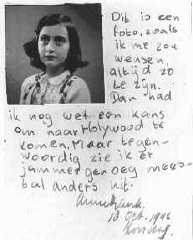
Anne Frank at five years of age. Bad Aachen, Germany, September 11, 1934.

Margot and Anne Frank before their family fled to the Netherlands. Bad Aachen, Germany, October 1933.

Anne Frank, age twelve, at her school desk. Amsterdam, the Netherlands, 1941.
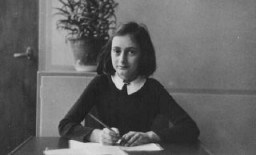
A page from Anne Frank's photo album showing snapshots taken between 1935 and 1942. Amsterdam, the Netherlands.
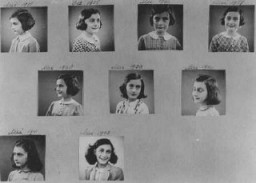
The house at Prinsengracht 263, where Anne Frank and her family were hidden. Amsterdam, the Netherlands. After 1935.

Passport photograph of Raoul Wallenberg. Sweden, June 1944.

Hungarian Jews wait in front of the Swedish legation main office in hopes of obtaining Swedish protective passes. Budapest, Hungary, 1944. Photograph taken by Tom Veres, who was active in Raoul Wallenberg's efforts to rescue the Jews of Budapest.
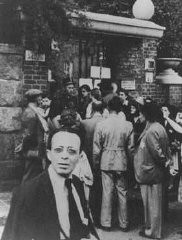
Swedish "protective pass" issued to Lili Katz, a Hungarian Jew. The document was initialed by Raoul Wallenberg (bottom left). Budapest, Hungary, August 25, 1944.
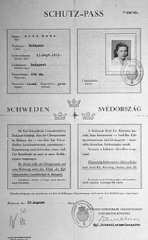
Swedish protective pass issued to Joseph Katona, the Chief Rabbi of Budapest. Budapest, Hungary, September 15, 1944.

A protective pass issued by the Swiss consulate in Budapest, for Chief Rabbi Joseph Katona. Budapest, Hungary, October 23, 1944.
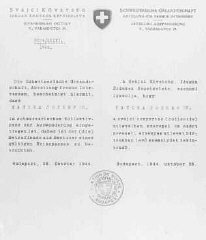
A group of Hungarian Jews rescued from deportation by Swedish diplomat Raoul Wallenberg. Budapest, Hungary, November 1944.
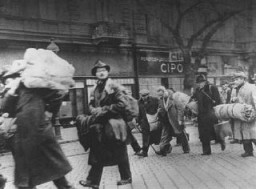
At the Jozsefvarosi train station in Budapest, Raoul Wallenberg (at right, with hands clasped behind his back) rescues Hungarian Jews from deportation by providing them with protective passes. Budapest, Hungary, 1944.

Memorial to Raoul Wallenberg, Swedish diplomat who rescued Jews in Budapest by issuing protective passes. Budapest, Hungary.
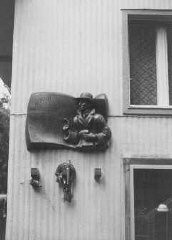
Memorial sculpture in honor of Swedish diplomat Raoul Wallenberg, who helped rescue Jews from the Nazis. Budapest, Hungary, 1990.
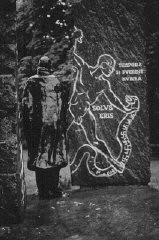
Vegetable gardens administered by the American Friends Service Committee as part of a Quaker relief effort for prisoners at the Gurs camp. Gurs, France, ca. 1943.
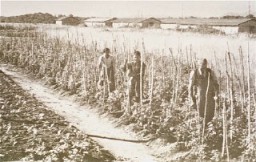
A woman (right) imprisoned in the Gurs camp stands with two Quaker delegates who worked for the American Friends Service Committee. Gurs, France, after January 1941.

Rufus Jones (seated) and Clarence Pickett were chairman and executive secretary of the American Friends Service Committee (AFSC), respectively. They are pictured here at a Quaker meeting in Philadelphia. The AFSC assisted Jewish and Christian European refugees. Philadelphia, United States, January 22, 1943.
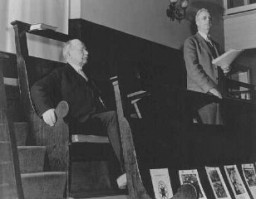
SS and Police Leader Juergen Stroop interrogates two Jews arrested during the Warsaw ghetto uprising. Poland, April 19-May 16, 1943.
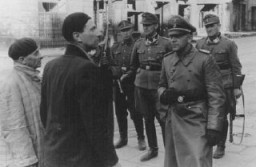
Jewish homes in flames after the Nazis set residential buildings on fire in an effort to force Jews out of hiding during the Warsaw ghetto uprising. Poland, April 19–May 16, 1943.
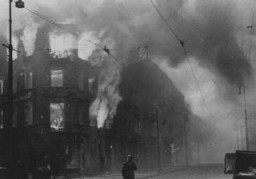
Jewish partisans, survivors of the Warsaw ghetto uprising, at a family camp in Wyszkow forest. Poland, 1944.
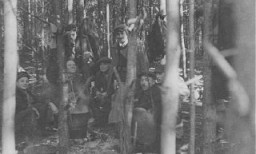
Partisans in the Naliboki forest, near Novogrudok. They were from various fighting units including the Bielski group and escapees from the Mir Ghetto on guard duty at an airstrip in the Naliboki Forest. Poland, July 1944.
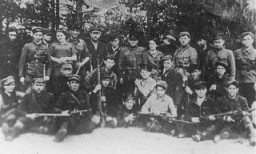
Photograph of Jewish parachutist Haviva Reik taken before her mission to aid Jews in Slovakia during the Slovak national uprising. Palestine, before September 1944.
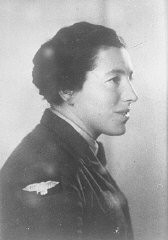
Hannah Szenes on her first day in Palestine. Haifa, Palestine, September 19, 1939. Between 1943 and 1945, a group of Jewish men and women from Palestine who had volunteered to join the British army parachuted into German-occupied Europe. Their mission was to organize resistance to the Germans and aid in the rescue of Allied personnel. Hannah Szenes was among these volunteers. Szenes was captured in German-occupied Hungary and executed in Budapest on November 7, 1944, at the age of 23.
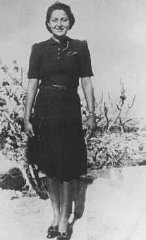
Simone Schloss, a Jewish member of the French resistance, under guard after a German military tribunal in Paris sentenced her to death. She was executed on July 2, 1942. Paris, France, April 14, 1942.
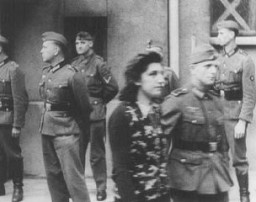
Former Jewish partisan leader Abba Kovner testifies for the prosecution during the trial of Adolf Eichmann. May 4, 1961.
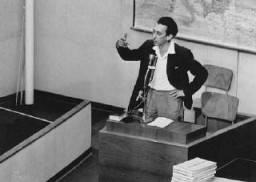
During his trial, defendant Adolf Eichmann reads a chart outlining the administrative hierarchy of the German Third Reich. Jerusalem, Israel. June 27 1961.
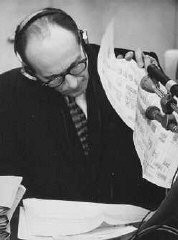
Abraham Lewenson testifying at the trial of Adolf Eichmann. Jerusalem, Israel, June 2, 1961. The Eichmann trial created international interest, bringing Nazi atrocities to the forefront of world news. Testimonies of Holocaust survivors generated interest in Jewish resistance. The trial prompted a new openness in Israel as the country confronted this traumatic chapter.
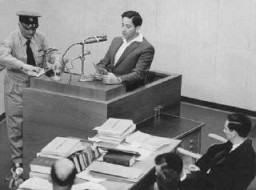
Defendant Adolf Eichmann identifies the city of Danzig (Gdansk) on a map during his trial in Jerusalem. Israel, July 18, 1961.
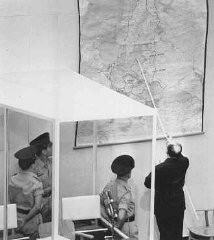
Inmates at forced labor in the Ravensbrück concentration camp. Germany, between 1940 and 1942.

A column of Jewish forced laborers. Sarospatok, Hungary, 1941.
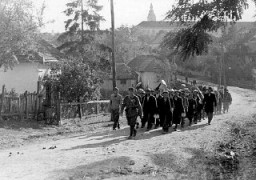
Returning from work in a stone quarry, forced laborers carry stones more than six miles to the Buchenwald concentration camp. Germany, date uncertain.
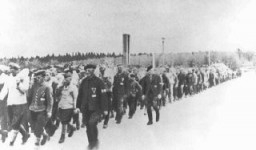
Jewish forced laborers in the quarry of a forced-labor camp established by the Hungarian government. Tokaj, Hungary, 1940.

Jews from a Slovak labor battalion working at road building. Slovakia, December 1941.

Prisoners at forced labor in the Siemens factory. Auschwitz camp, Poland, 1940–44.
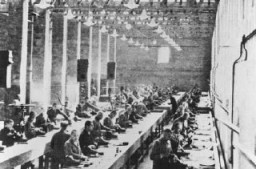
We would like to thank Crown Family Philanthropies, Abe and Ida Cooper Foundation, the Claims Conference, EVZ, and BMF for supporting the ongoing work to create content and resources for the Holocaust Encyclopedia. View the list of donor acknowledgement.